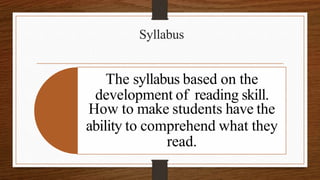ppt-readingapproach-201014070716 (1) (2).pptx
- 2. Background English becomes an International Language. It demands all the society in every background especially the students to master it well. Reading approach is one of the way to help the students solve their problem in reading In reading approach, many things an be achieved by the students and they can master English well
- 3. Definition A reading approach is a way to start teaching beginning readers.
- 5. A Brief History Reading approach or reading method was first devised for English learners in India and French or German learners in the United States of America who have not the time to master the ŌĆ£activeŌĆØ or oral use of the language. It has also been advocated in England for pupils of inferior language-learning ability. Reading approach is like GTM (Grammar Translation Method) since it also stressed on written skills. Only the grammar necessary for reading comprehension and fluency is taught. But, it was flexible approach as far as the teaching is concerned.
- 6. Theory of Language Reading approach is a way to start teaching beginning readers. It is based on cognitive theory originally conceptualized by Albert Bandura
- 7. Theory of Learning Reading Comprehension level of understanding Round Robin reading following a set order
- 8. Objective ŌĆō The students are able to identify meaning rather than letters or words ŌĆō The students are able to understand and read the text quickly ŌĆō The students are able to read actively
- 9. Syllabus The syllabus based on the development of reading skill. How to make students have the ability to comprehend what they read.
- 10. Types of Teaching and Learning Activities Skimming, It is an activity to read shorter texts to extract accurate detailed information. Skimming is used to quickly identify the main ideas of a text. Skimming is done at a speed three to four times faster than normal reading Scanning, It is a quickly reading a text to get the gist of it Extensive reading, extensive reading is a reading longer text, usually for pleasure. Extensive reading is an approach to language learning, including foreign language learning, by the means of a large amount of reading. Intensive reading.
- 11. The role of extensive reading in language learning: It can provide ŌĆścomprehensible input. It can enhance learnersŌĆÖ general language competence. It increases the studentsŌĆÖ exposure to the language. It can increase knowledge of vocabulary. It can lead to improvement in writing. It can motivate learners to read. It can consolidate previously learned language.
- 12. Kinds of instructional experiences and materials Reading aloud Shared reading. Word study Guided reading Independent reading
- 13. ŌĆó Learner Roles - Recognizing the script of a language. - Translating the text. - Deducing the meaning of unfamiliar lexical items. - Understanding explicitly stated information. ŌĆó Teacher Roles Teacher should create situations in which learners are most suggestible and then to present linguistic material in a way most likely to encourage positive reception and retention by learners. ŌĆō ŌĆō ŌĆō Motivating learners Encouraging to set reading strategies Supporting the students to develop reading comprehension
- 14. The Role of Instructional Materials To get meaning from whole chunks of text To have good vocabulary and integrate naturally with other class work.
- 15. ŌĆó The teacherteachesstudents about prior knowledge ŌĆó Making aconnection is when a student can relate a passage to an experience, another book, or other facts about the world ŌĆó Questioningis another strategy that will greatly benefit a student. ŌĆó Visualization is when a student can create a picture or movie in their mind while reading text. Use terms like ŌĆ£mental imageŌĆØ and asking sensory questions will help students become better visualizers. ŌĆó Summarizing is a comprehension strategy that also needs to be taught. Summarizing is telling what is important about the text. ŌĆó Evaluation is about making judgments on what you read and then explaining why you made those judgments (Into the Book). ŌĆó Synthesizing is putting the pieces together to see them in a new way (Into the Book).
- 16. Advantages of Reading Approach Reading approach can be used in a big class. In reading approach, students can know much vocabulary because they have to read the passage. Students focus what they are studying because they only learn grammar. The reading method requires little teaching skill since the lesson-form is a standardized and fixed procedure. The reading method is economical of time since the pupils all read simultaneou sly.
- 17. Disadvantages of Reading Approach Since reading approach is only focused on written skill, this approach is lack in speaking skill. Reading approach is oppressive approach because the vocabularies and grammar are controlled.
- 18. Thank you

















